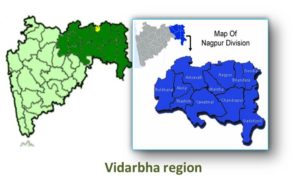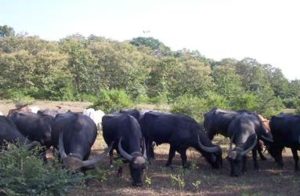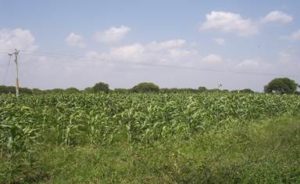NAGPURI
- Origin & Breeding Tract
- Population
- Physical Characteristics
- Biometry
- Reproduction Traits
- Production Traits
- Housing Management & Practices
The Nagpuri buffalo is a versatile breed of the Vidarbha region of Maharashtra State and stands better amongst the breeds of buffaloes which combine the milk and drought qualities in a better proportion in adverse climatic conditions. The animals of this breed are very well adapted to the harsh-semi-arid conditions of Vidarbha region and can withstand extreme climatic conditions as high as 47º C even in respect of milk production and fertility. This breed derives its name from Nagpur district and is popularly called Varhadi (Berari), Ellicpuri / Achalpuri, particularly in Akola, Amravati, Buldhana and Yavatmal districts.

 The traditional breeding tract of this breed covers an area of 41,105 sq. km. and a considerable part of the tract is semi-arid and suffers acute water storage. The maximum temperature ranging between 46-47ºC is not uncommon during the peak summer season. The natural breeding tract of the breed is Ellichpur (Achalpur), Paratwada, Daryapur and Anjangaon-Surji tehsils of Amravati districts .
The traditional breeding tract of this breed covers an area of 41,105 sq. km. and a considerable part of the tract is semi-arid and suffers acute water storage. The maximum temperature ranging between 46-47ºC is not uncommon during the peak summer season. The natural breeding tract of the breed is Ellichpur (Achalpur), Paratwada, Daryapur and Anjangaon-Surji tehsils of Amravati districts . 

Typical specimens of Nagpuri buffalo are also found in the vicinity of Arvi tehsil of Wardha district . These animals in their pure form are found in Degma and Kavdas villages of Hingna tehsil; Kathlabodi and Rohna villages of Katol tehsil of Nagpur district . Jamwadi, Kalamb, Chaparda, Ghoti and Jamb-bazar villages in Yavatmal district are the main pockets of this breed. People of Nanda-gawalis and Gosavi communities are found to own this breed. Occupying isolated hamlets in remote villages, they claim to be descendants of cow-herd friends of Lord Krishna. Nanda-Gawalis rear only Nagpuri buffaloes . Source: A. R. Sirothia, D.S. Kale and S.B. Kamble
Maharashtra possesses three recognized indigenous breeds of buffaloes which belong to different regions of state. These are Nagpuri, Pandharpuri and Marathwadi buffaloes. Many other lesser known strains like Purnathadi, Tambati, Gawalgan and Shinagali also exist but these have not been defined as breeds yet.
Out of 63.03 lakhs buffalo population (Livestock Census 2007, Govt. of M.S.) in the state, around 25.16 % belong to indigenous breed like Nagpuri (2.11%), Pandharpuri (4.17%) and Marathwadi (2.90%). It is also observed from the record that a large segment of buffalo population (about 74.84%) in the state is considered to be non-descript because these animals do not fulfill the phenotypic attributes to any specific breeds.
.
| Breed | Livestock Census(1997) |
Livestock Census (2003) |
Livestock Census(2007) |
% Change/annum |
||
| 1997-2003 | 2003-2007 | 1997-2007 | ||||
| Nagpuri |
4.22 (6.96) |
2.29 (3.76) |
1.33 (2.11) |
(-) 9.14 |
(-) 8.39 |
(-) 13.69 |
.
Though the overall proportion of buffalo in the state is increasing at the rate of 0.75 per cent per annum during the last 10 years (1997-2007), yet the proportions of pure breed Nagpuri, Pandharpuri and Marathwadi buffaloes are declining at the rate of (-)13.69,(-)11.24 and (-)11.38 per cents respectively per annum. Similar declining trend was also reported by Sirothia et. al. (2004) in the population of Nagpuri buffalo from Nagpur, Akola, Yavatmal and Amrawati districts of Vidarbha region of Maharashtra. Increase in the population of Murrah in Vidarbha region and decrease in the population of Nagpuri buffalo indicates a shift towards high milk production rather than high fat producing buffaloes in the native tact of Nagpuri breed. This trend is dangerous for existence of this precious germplasm.
The major factor affecting the purity is the scarcity of pure breed Nagpuri bulls in its breeding tract. Murrah and Surti semen is generally available for breeding these animals at the A.I. centers of Animal Husbandry Department, Govt. of Maharashtra. This has resulted in genetic erosion of the Nagpuri buffalo in terms of purity. Very recently the Maharashtra Livestock Development Board (MLDB) has purchased 12 good quality Nagpuri bull calves from the resource farmers – Nand-gawali community of the breeding tract. At present these calves are being maintained at the Bull Rearing Center (BRC), Telankhedi, Nagpur, Dept of AHDS Govt. of Maharashtra and will be used for semen collection for future breeding programmes in the native tract of the breed.
Some of the important characteristics is described as follows: –
|
Body color |
Black(82.05%), Bhura/Brown(17.5%) with White patches on face, legs and tail. |
|
|
Horns |
Long flat, wide and thick at the base carried backwards in each side of the neck nearly upto the shoulders resembling like a pair of swords. Length (cm) Male: 54-55 and Female: 61-62 |
|
|
Marking |
White patches on face, legs and tail. | |
|
Eye |
||
|
Tail |
Short tail with white patches Length (cm) Male: 54-55 and Female: 51-52. |
|
|
Body |
Medium sized animals. Body Weight (kg) Male:400 and Female: 375. |
|
|
Head |
Long and thin, cone shaped face with straight nasal bone.Depending upon the degree of white patches on the forehead and nasal portion these animals are locally called as “Ardh-Chandri, Chandri, Gal-Bhondi and Kapal-Bhondi”. |
|
|
Face |
Face is long and thin,cone shaped with straight nasal bone. |
|
|
Neck |
Long with compact and cylindrical barrel. |
|
|
Ear |
Ears are medium in size with pointed tips. |
|
|
Limbs |
Limbs are long and light. |
|
|
Skin |
||
|
Udder |
||
|
Teats |
Body weight and Growth Rate
The mean values of body weight at birth, 6, 9,12,18,24 months and at first calving reported by various workers are presented below.
| Stage | Mean +- S.E(Kg) | Reference |
| At Birth | ||
| 3 months | ||
| 6 months | ||
| 9 months | ||
| 12 months | ||
| 18 months | ||
| 24 months | ||
| At first calving |
.
Morphological Characteristics
Various values of morphological traits of Nagpuri buffaloes like body length, height at withers, heart girth and adult weight are given in the following table.
| characteristics | No.of Animals | Mean ±S.E | Reference |
| Body Length(cm) | 2142 | 121.21±0.46 | Sirothia et al.(2004) |
| Height at withers(c) | 2142 | 123.62 ± 0.32 | Sirothia et al.(2004) |
| Hearth Girth(cm) | 2142 | 175.02 ± 0.53 | Sirothia et al.(2004) |
| Birth Weight(Kg) | 2142 | Sirothia et al.(2004) | |
| Adult weight(Kg) | 138 |
(F) 349.26 ±2.01 (M) 396.19±12.76 |
Sirothia et al.(2004) |
- Male
| Traits | Values |
| Age at puberty (months) | – |
| Age at first training(months) | – |
| Age at first ejaculation(months) | – |
| Age at first mating(months) | – |
.
- Female
| Traits | No. of Animals | Mean+-S.E | Reference |
| Age at puberty (months) | 2021 | 1360.33 | Sirothia et al.(2004) |
| Age at First Calving (months) | 2021 | 1775.72±38.83 | Sirothia et al.(2004) |
| Service Period(days) | 2021 | 115.9±1.08 | Sirothia et al.(2004) |
| Dry Period(days) | 1914 | 122.78 ± 7.34 | Sirothia et al.(2004) |
| Calving Interval(days) | 2021 | 426.44±0.81 | Sirothia et al.(2004) |
| Estrous Cycle Length(days) | |||
| Estrousn Duration (hrs) | |||
| Gestation Length (days) |
Sirothia et al. (2004) indicated average lactation yield of 1038.49 ± 39.56 kg in Nagpuri buffaloes reared under village conditions of Vidarbha.
| Traits | No. of Animals | Mean±S.E | Reference |
| Average lactation length (days) | 1914 | 303.26±16.80 | Sirothia et al.(2004) |
| Average 305 day lactation milk yield (kg) | 1914 | 1038.49±39.56 | -Do- |
| Average daily milk yield (kg) | 1914 | 5.15 ± 0.23 | -Do- |
| Peak milk yield (kg) | 1914 | 7.14 ± 0.25 | -Do- |
| Average Fat% | 1914 | 8.21 ± 0.19 | -Do- |
| Average SNF% | – | – |
Housing
Majority of the farmers from the breeding tract of Nagpuri buffalo tie their animals during night only and open houses are provided to most of them. About (63%) the farmers have separate houses for the animals and majority of animal houses (86%) are Kachha only.
Feeding
In the breeding tract of Nagpuri buffalo, farmers usually reared 1-3 adult units on their landholdings. Milk is produced for the family at minimal cost. Grazing provides most of the feed requirements of animals. Some roughages and small quantity of concentrates are given only to milking animals.



Farmers in the four districts Nagpur, Akola, Amravati and Yavatmal have average land holding of 8.01 acres with 4.38 acres irrigated land and annual income of Rs. 70,600/- (Kataria et al.2007). Amravati district had higher averages for these as compared to other three districts. Better socio-economics status and better adaptability of animals to the agro-climatic conditions of Amravati district were attributed to higher Nagpuri buffalo population in this district. Most of the region is covered with dark brown to black soil and hilly region has brown soil mix with sand. The region is well known for cotton production. Sorghum and ground-nut are other major crops along with cultivation of weat, maij, bajara and ragi.

